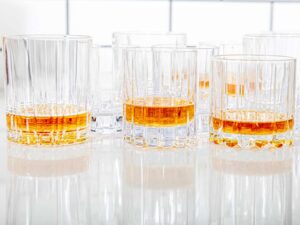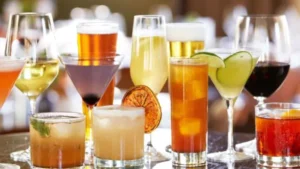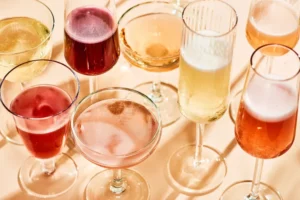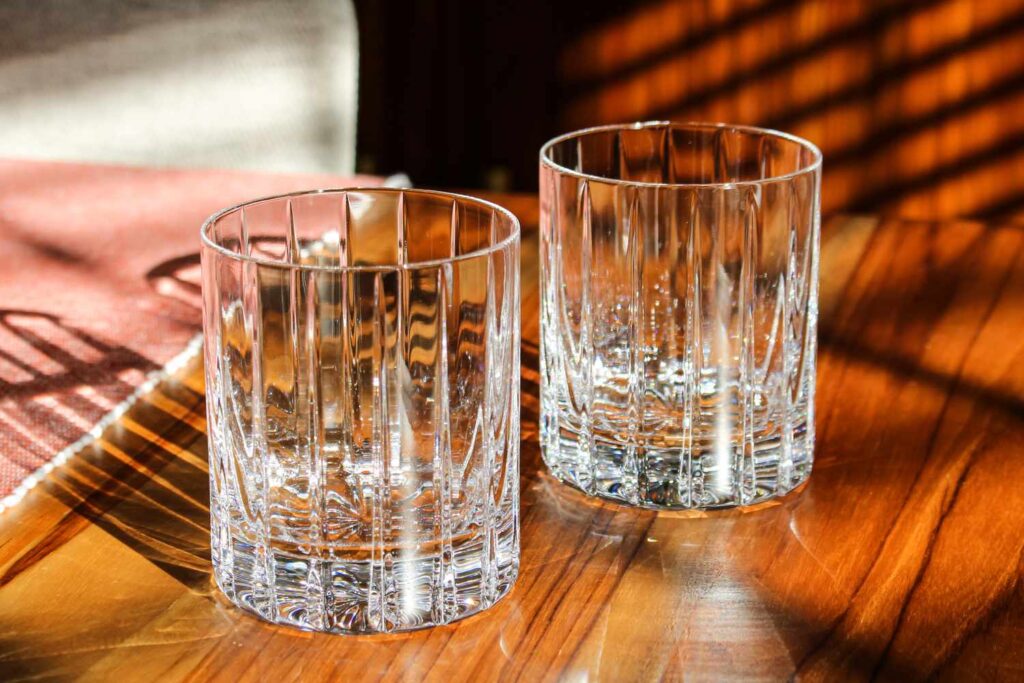The old-fashioned glass stands as a quiet titan in the world of drinkware. Unassuming yet iconic, it’s the cornerstone of countless home bars and professional establishments alike. Often called a rocks glass or lowball, its simplicity belies its incredible versatility and deep-rooted history. This sturdy, thick-bottomed tumbler isn’t just a container; it’s a stage for crafting classic cocktails, savoring fine spirits neat, or enjoying a simple evening refresher. Its enduring design, focused on functionality and tactile pleasure, has transcended fleeting trends, securing its place as an essential piece for anyone who appreciates the ritual and enjoyment of a well-made drink. Truly, the old-fashioned glass is a testament to timeless design.
A Toast to History: The Origins of the Old Fashioned Glass

The story of the old-fashioned glass is intrinsically linked to the cocktail it famously serves: the Old Fashioned. Emerging in the early 19th century, cocktails were initially simply spirits, sugar, water, and bitters. As mixology evolved, adding liqueurs, fruits, and other embellishments became common. Purists longing for the original, simpler preparation would ask bartenders for a cocktail made the “old-fashioned way.” This drink demanded a specific vessel – sturdy enough for muddling sugar and bitters, capacious enough for ice and spirit, and stable enough to handle the stirring. Enter the short, solid tumbler.
While the exact origin date is hazy, the design solidified (literally and figuratively) by the late 1800s and early 1900s. Early versions were often made of thick, pressed glass, prized for their durability in bustling saloons and homes. The design prioritized substance over delicate flair – a wide base for stability, straight or slightly tapered sides for easy handling and stirring, and that signature thick bottom. This bottom wasn’t just for looks; it provided weight, preventing easy tipping, and offered some insulation against the warmth of the hand, slowing ice melt. The old-fashioned glass, born from practicality, quickly became synonymous with enjoying spirits and simple mixed drinks “on the rocks.”
Anatomy of an Icon: What Defines an Old-Fashioned Glass?
So, what makes a glass an old-fashioned glass? It’s a specific set of characteristics:
-
Shape: Typically short and wide with a broad base. Sides are usually straight or taper slightly inward towards the top. This shape provides ample surface area for aroma release and easy access for stirring or adding garnishes.
-
Capacity: The standard old-fashioned glass holds between 6 to 10 ounces (180-300 ml). This capacity is ideal for drinks built directly in the glass with ice, like the Old Fashioned, Negroni, or a simple whiskey on the rocks. It allows room for ingredients and ice without being overly large.
-
The Thick Bottom: This is arguably the most defining feature. The substantial base provides:
-
Stability: Makes the glass hard to tip over accidentally.
-
Weight & Feel: Gives the glass a satisfying heft and premium feel in the hand.
-
Insulation: The thick glass acts as a slight buffer, slowing the transfer of heat from the hand to the drink, thus reducing ice melt.
-
Durability: Adds strength to withstand the pressure of muddling ingredients.
-
-
Material: Traditionally made from glass (crystal or soda-lime). Crystal offers superior clarity, brilliance, and a thinner rim for a better drinking experience, while often being more delicate. Soda-lime glass is more durable and affordable. Modern variations can be found in high-quality acrylic for outdoor use or double-walled stainless steel for temperature retention, but the classic remains glass. The material significantly impacts the glass’s look and feel.
-
Functionality: Every aspect is designed for use. The wide opening allows the nose to get close to the spirit, enhancing the olfactory experience. The shape facilitates easy stirring with a bar spoon. The capacity is perfect for single-serving cocktails built in the glass.
This combination of form and function is why the old-fashioned glass design has remained virtually unchanged for over a century. It simply works perfectly for its intended purpose.
Beyond the Name: Rocks Glass, Lowball, and the Double

You’ll often hear the old-fashioned glass called by other names, primarily “rocks glass” or “lowball glass.” Generally, these terms are used interchangeably to refer to the same style of glass described above. The name “rocks glass” directly references its primary use: serving spirits “on the rocks” (over ice). “Lowball” contrasts with the taller “highball glass” used for longer mixed drinks like gin and tonics or rum and cola.
However, a close cousin exists: the Double Old Fashioned glass (DOF). As the name suggests, this is essentially a larger version of the standard old-fashioned glass, typically holding between 12 to 16 ounces (350-475 ml). It shares the same thick-bottomed, sturdy design but offers more capacity. The Double Old Fashioned glass is perfect for:
-
Larger whiskey pours on the rocks.
-
Cocktails that require more ingredients or larger ice cubes/spheres.
-
Drinks with substantial garnishes.
-
Serving neat spirits to those who prefer a larger vessel.
-
Enjoying a generous pour of water or juice.
Both the standard old-fashioned glass and the Double Old Fashioned glass are staples, with the choice often depending on personal preference for size and the specific drink being served. The classic old-fashioned glass remains the most iconic and versatile size for everyday use. Adding a Double Old Fashioned glass to your collection expands your options beautifully.
More Than Just Whiskey: The Versatile Uses of the Old Fashioned Glass
While forever linked to whiskey and its eponymous cocktail, the old-fashioned glass is astonishingly versatile. Its robust design and comfortable size make it suitable for a wide array of beverages:
-
The Classics:
-
Old Fashioned: Obviously! The muddling of sugar, bitters, and citrus peel, followed by whiskey and ice, happens right here.
-
Whiskey/Rum/Bourbon/Scotch Neat or On the Rocks: The wide bowl allows the spirit to breathe, releasing complex aromas enjoyed with each sip. The thick base feels substantial with a premium pour.
-
Negroni: Equal parts gin, Campari, and sweet vermouth, stirred with ice and garnished with orange peel – perfectly at home in an old fashioned glass.
-
Americano: Campari, sweet vermouth, and soda water – a lighter cousin to the Negroni.
-
Sazerac: While traditionally served in a chilled glass, the final build often lands in an old fashioned glass.
-
Boulevardier: Similar to a Negroni but substituting bourbon for gin.
-
Improved Whiskey Cocktail: An evolution of the Old Fashioned, often including additional liqueurs like Maraschino.
-
-
Spirit-Forward Sippers: Any spirit enjoyed neat, with a splash of water, or over ice benefits from the aromatic delivery of this glass. Think aged rums, sipping tequilas (añejo or extra añejo), or fine brandies and cognacs.
-
Dessert & After-Dinner Drinks:
-
Port, Sherry, Madeira: The smaller serving size of fortified wines fits perfectly.
-
Dessert Wines (Sauternes, Ice Wine): The glass concentrates the luscious aromas.
-
Liqueurs (Grand Marnier, Amaretto, Frangelico): Sipped slowly after a meal.
-
Irish Coffee (Smaller Portion): Though often in a mug or stemmed glass, a sturdy old fashioned glass works well for a smaller version.
-
-
Non-Alcoholic Delights:
-
Fancy Sodas/Juices: Serve a premium ginger beer, craft soda, or freshly squeezed juice over ice for a refreshing treat. The weight feels special.
-
Iced Tea/Coffee: Perfect for a short, strong serving over ice.
-
Desserts: Think individual portions of mousse, panna cotta, trifle, or ice cream sundaes. The old fashioned glass makes for an elegant presentation.
-
Small Snacks: Nuts, olives, or small candies.
-
The old-fashioned glass transitions effortlessly from a serious whiskey vessel to a charming dessert cup, proving its incredible adaptability. It’s a true workhorse in any kitchen or bar.
The Allure of Vintage and Specialty Old Fashioned Glasses
For collectors and enthusiasts, Vintage old-fashioned glasses hold a special fascination. These glasses, often dating from the early 20th century through the mid-century modern era, offer unique charm and history:
-
Patterns & Designs: Pressed glass patterns like “Star of David,” “Hobnail,” or “Block Optic” were incredibly popular. Mid-century designs might feature bold colors, atomic motifs, or sleek, minimalist lines. Cut crystal versions offer intricate brilliance.
-
Materials & Techniques: Early glasses used thicker, often slightly imperfect, pressed glass. Depression glass introduced colors like green, pink, and amber. Crystal versions showcased superior craftsmanship.
-
The Hunt & Value: Finding a matching set or a unique pattern adds thrill. Value depends on rarity, condition, pattern popularity, and maker (like Fostoria, Anchor Hocking, Cambridge Glass). While some rare pieces command high prices, many beautiful vintage old fashioned glass sets are affordable and add instant character to a bar cart.
-
Authenticity & Use: Using vintage glassware connects us to the past. They often have a wonderful heft and character missing from some modern mass-produced glasses. Ensure they are free of cracks or chips, especially if made with leaded crystal (though generally safe for occasional use, prolonged storage of acidic liquids isn’t recommended).
Beyond vintage, contemporary specialty old fashioned glass designs abound:
-
Crystal Masterpieces: Brands like Waterford, Baccarat, or Riedel offer exquisite hand-cut crystal glasses that refract light beautifully and provide an ultra-thin lip.
-
Modern Artistry: Designers create unique takes, from asymmetrical shapes to textured surfaces or colored stems (though stemless is traditional).
-
Themed & Novelty: Glasses featuring logos, specific characters, or holiday themes add fun for casual gatherings.
-
Insulated & Alternative Materials: Double-walled glass or stainless steel versions keep drinks colder longer without dilution. Durable acrylic is great for pool sides or patios.
Whether drawn to the history of vintage or the innovation of modern design, there’s a specialty old-fashioned glass to suit every taste and occasion.
Building Your Collection: Old-Fashioned Glass Sets and Buying Considerations

An Old Fashioned Glass Set is a fundamental starting point for any home bar. Sets typically include 2, 4, 6, or 8 glasses, ensuring you have enough for guests and daily use. Here’s what to consider when choosing yours:
-
Material & Quality:
-
Crystal: Offers superior clarity, brilliance, resonance (a pleasant ring when tapped), and a thinner, more refined rim. More delicate and often requires hand washing. Lead-free crystal options are widely available. This elevates the experience but comes at a higher price point.
-
Soda-Lime Glass: More durable, affordable, and often dishwasher safe. Look for glasses with good clarity, minimal seams, and a decently thick base for that satisfying feel. Many excellent, durable options exist in this category. Tempered glass offers extra strength.
-
Alternative Materials: Acrylic for safety (pools, outdoors), stainless steel for insulation. Great for specific scenarios but lack the classic look and feel of glass.
-
-
Size Preference: Do you prefer the standard old fashioned glass (6-10 oz) or the larger Double Old Fashioned glasses (12-16 oz)? Many sets offer one or the other. Some versatile sets might include both sizes. Consider what you drink most often.
-
Design & Aesthetics:
-
Classic: Simple, straight-sided, heavy base. Timeless and versatile.
-
Etched/Engraved: Subtle patterns or monograms add personalization.
-
Colored Glass: Adds a pop of color to your bar cart (e.g., classic amber for whiskey, blue, green).
-
Textured/Patterned: Adds visual interest and grip.
-
Stemmed Variations: Less common, but some modern designs add a short stem for a different look and feel.
-
-
Weight & Feel: This is crucial! A good old-fashioned glass should feel substantial and balanced in the hand. The weight conveys quality. Hold it before you buy, if possible, or read reviews emphasizing heft.
-
Durability & Care: If you use a dishwasher frequently, ensure the glasses are labeled dishwasher safe (soda-lime glass usually is, crystal often is not). Consider the likelihood of chipping. Thicker rims might be less prone to chipping than very thin crystal rims.
-
Price Point: Old-fashioned glass price varies enormously.
-
Budget: Basic soda-lime glass sets can be found for $2-$5 per glass.
-
Mid-Range: Higher quality soda-lime or basic crystal sets range from $10-$25 per glass.
-
Premium: Fine crystal or designer glasses can range from $30 to well over $100+ per glass.
-
Where to Buy: Department stores (Crate & Barrel, Williams Sonoma), specialty kitchenware shops, online retailers (Amazon, Wayfair), antique stores/vintage markets (for vintage sets), and directly from glassmakers (like Riedel, Schott Zwiesel, Libbey) or luxury brands (like Moser).
Investing in a good Old Fashioned Glass Set enhances the enjoyment of your drinks and adds sophistication to your entertaining. Start with a classic set of 4 or 6 in sturdy soda-lime glass or mid-range crystal, and expand from there.
Styling and Serving: Making the Most of Your Old Fashioned Glasses
The old fashioned glass isn’t just functional; it’s a key element of your drink presentation and home bar aesthetic. Here’s how to make them shine:
-
The Bar Cart/Cabinet: Display your glasses prominently. Group matching old fashioned glass sets together. Mixing different styles (e.g., a couple of vintage with modern) can create eclectic charm. Ensure they are clean and sparkling!
-
Ice Matters: The right ice elevates a drink in an old fashioned glass.
-
Large Format Ice: One large cube or sphere melts slowly, minimizing dilution. Requires specific ice molds. Ideal for whiskey neat or on the rocks and spirit-forward cocktails.
-
Kold-Draft Style: Clear, dense cubes made in specialized trays or machines. Professional look, melts slower than standard freezer ice.
-
Cracked Ice: For drinks like the Mint Julep (often served in a Julep cup, but sometimes a DOF) or when faster chilling/dilution is desired. Use a Lewis bag and mallet.
-
-
Garnishes with Gusto: Garnishes add visual appeal and aromatic complexity.
-
Citrus Twists: Expressed over the drink to release oils, then draped on the rim or dropped in.
-
Cherries: Luxardo Maraschino cherries are the classic for an Old Fashioned. Avoid overly sweet, dyed supermarket versions.
-
Herbs: A mint sprig for certain whiskey sours or Juleps.
-
Spices: A cinnamon stick or star anise can add warmth to autumnal drinks.
-
Edible Flowers: For a delicate, elegant touch on lighter cocktails or non-alcoholic drinks.
-
-
Glassware Care: Presentation starts with pristine glassware.
-
Polishing: Buff with a lint-free cloth after washing/drying to remove water spots and fingerprints. This is essential for crystal.
-
Hand Washing: Always recommended for crystal and vintage glasses. Use mild detergent and warm water. Dry immediately.
-
Dishwasher: Only if specifically labeled safe. Use a gentle cycle. Place carefully to avoid chipping. Avoid excessive heat drying settings if possible.
-
-
Themed Settings: Use colored or vintage old-fashioned glasses to match a party theme or holiday decor. Amber glasses for a fall gathering, vintage pastels for a garden party.
Taking these extra steps transforms serving a drink in an old-fashioned glass from routine to ritual, enhancing the overall sensory experience for you and your guests.
Choosing the Perfect Old Fashioned Glass: A Buyer’s Guide

With so many options, selecting the right old-fashioned glass can feel overwhelming. Focus on these key factors:
-
Primary Use: What will you mostly drink from it?
-
Whiskey Neat/Rocks? Prioritize a crystal for aroma or a heavy-based classic glass. Standard size is usually sufficient.
-
Cocktails (Old Fashioned, Negroni)? Ensure the base is thick enough for muddling. Standard size is ideal.
-
Larger Drinks/Ice Spheres? Opt for a Double Old Fashioned glass.
-
Desserts/Non-Alcoholic? Durability and aesthetics might be key. Any style works!
-
-
Feel is Fundamental: This cannot be overstated. The old-fashioned glass is held constantly while drinking. It must feel comfortable and substantial. If buying online, look for descriptions like “heavy base,” “substantial weight,” or “luxurious feel.” If in-store, pick it up! Does it feel cheap and flimsy, or solid and well-crafted? The weight should feel balanced.
-
Material Match:
-
Crystal Connoisseur: If you appreciate the finest details, clarity, and a thin rim, invest in lead-free crystal. Accept the need for careful hand washing.
-
Durability First: For everyday use, parties, or dishwashing, high-quality soda-lime glass is the practical and often beautiful choice. Tempered glass adds extra resilience.
-
Outdoor Enthusiast: Durable acrylic or stainless steel are best for patios, pools, or camping. They won’t break if dropped on concrete.
-
-
Size Selection: Revisit the Standard vs. Double decision. If unsure, a standard 8-10oz old fashioned glass is the most versatile starting point. You can always add DOFs later.
-
Style & Budget:
-
Define your aesthetic (minimalist, vintage, modern, luxurious).
-
Set a realistic budget per glass. Remember, you often get what you pay for in terms of feel and durability. A good mid-range set ($15-$25 per glass) often offers the best balance.
-
-
Brand Reputation & Reviews: Research brands known for quality glassware (Libbey for reliable affordability, Schott Zwiesel for Tritan crystal durability, Riedel for precision, Moser for luxury hand-crafted crystal). Read customer reviews focusing on weight, feel, durability, and clarity.
The perfect old fashioned glass is the one that feels right in your hand and suits your drinking habits and style. Don’t be afraid to start with an affordable, sturdy set and gradually add more specialized or premium pieces to your collection.
Caring for Your Treasured Tumblers: Maintenance Tips
To ensure your old fashioned glasses, whether everyday workhorses or prized crystal, last for years and always look their best, proper care is essential:
-
Hand Washing is King (Especially for Crystal & Vintage):
-
Use warm (not scalding hot) water and a mild, non-abrasive dish soap.
-
Wash one glass at a time to prevent clinking and chipping.
-
Use a soft sponge or cloth. Avoid abrasive scouring pads.
-
Pay attention to the bottom where residue can build up.
-
Rinse thoroughly under warm running water to remove all soap suds.
-
-
Drying: This is crucial to prevent water spots!
-
Immediately: Dry glasses right after washing and rinsing. Don’t let them air dry.
-
Lint-Free is Best: Use a dedicated, clean, lint-free cotton or microfiber glass towel.
-
Polish: Buff the glass, especially the exterior and base, to a sparkling shine. For crystal, this step is vital for maximum brilliance.
-
-
Dishwasher Use (If Labeled Safe):
-
Place glasses securely in the rack, ensuring they don’t touch each other or taller items that could shift and cause chipping during the cycle.
-
Use a gentle cycle with a mild detergent. Avoid harsh detergents or rinse aids with citrus additives, which can etch glass over time.
-
Consider skipping the heated dry cycle or opening the dishwasher immediately after the final rinse to let glasses air dry partially before polishing with a towel. Heat can contribute to cloudiness over many washes, especially on lower-quality glass.
-
-
Storing:
-
Store glasses upright.
-
If stacking, ensure they are completely dry first. Place a soft cloth or paper towel between stacked glasses to prevent scratching and sticking.
-
Avoid overcrowding shelves or cabinets. Give them space to prevent accidental knocks.
-
-
Stain & Cloudiness Removal:
-
Hard Water Stains/Cloudiness: Soak in a solution of equal parts white vinegar and warm water for 15-30 minutes. Scrub gently with a soft brush if needed, then wash and rinse thoroughly. For crystal, be very gentle and minimize soaking time. Commercial glass descalers are also available.
-
Lipstick/Oil Stains: Rub gently with baking soda paste or a cloth dampened with rubbing alcohol, then wash as usual.
-
Avoid Bleach: It can damage glass over time, especially crystal.
-
-
Handling: Be mindful when handling, especially around sinks or hard surfaces. The thick base makes them sturdy, but the rim is still vulnerable.
By following these simple steps, your old fashioned glasses will continue to look beautiful and perform flawlessly, ready to elevate your next drink.
Frequently Asked Questions (FAQs)
-
What is the standard Old Fashioned glass size?
The standard old fashioned glass typically holds between 6 and 10 ounces (180 – 300 ml). This size is ideal for building cocktails like the Old Fashioned or Negroni directly in the glass and for serving spirits neat or on the rocks. The Double Old Fashioned glass is larger, usually 12-16 ounces (350-475 ml). -
How much does an Old Fashioned glass cost?
Old fashioned glass price varies significantly based on material, brand, and quality. Basic soda-lime glass sets start around $2-$5 per glass. Good quality mid-range glasses (sturdy soda-lime or basic crystal) range from $10-$25 per glass. Premium crystal or designer old fashioned glasses can cost anywhere from $30 to well over $100 per glass. -
What are Old Fashioned glass uses besides cocktails?
The old fashioned glass is incredibly versatile! Beyond whiskey and cocktails like the Old Fashioned or Negroni, it’s perfect for neat spirits, dessert wines (Port, Sherry), liqueurs, serving premium sodas or juices over ice, individual desserts (mousse, ice cream sundaes, panna cotta), and even small snacks like nuts or olives. -
Where can I find Vintage Old Fashioned Glasses?
Vintage Old Fashioned Glasses can be found in antique stores, vintage markets, thrift stores, estate sales, and online auction sites (eBay, Etsy). Look for popular patterns like “Hobnail,” “Block Optic,” or “Star of David,” or brands like Fostoria or Anchor Hocking. Condition and rarity impact value. -
Should I buy an Old Fashioned Glass Set?
Purchasing an Old Fashioned Glass Set (usually 2, 4, 6, or 8 glasses) is highly recommended. It ensures you have matching glasses for consistency when serving guests, offers better value per glass compared to buying singles, and provides enough for everyday use. It’s a foundational barware purchase. -
What’s the difference between an Old Fashioned glass and a Double Old Fashioned glass?
The key difference is size. A standard old fashioned glass holds 6-10 oz, while a Double Old Fashioned glass (DOF) holds 12-16 oz. They share the same thick-bottomed, sturdy design. The DOF is ideal for larger pours of spirits on the rocks, cocktails with bigger ice cubes/spheres, more ingredients, or substantial garnishes. The classic old fashioned glass is the most versatile size.
Conclusion: A Timeless Essential
The old fashioned glass is far more than just a humble tumbler. It’s a piece of drinking history, a masterclass in functional design, and an indispensable tool for savoring life’s simple and sophisticated pleasures. From the ritual of muddling sugar and bitters for a classic Old Fashioned to the contemplative sip of a fine whiskey neat, from an elegant dessert presentation to a refreshing non-alcoholic spritzer, this versatile vessel proves its worth time and again.


